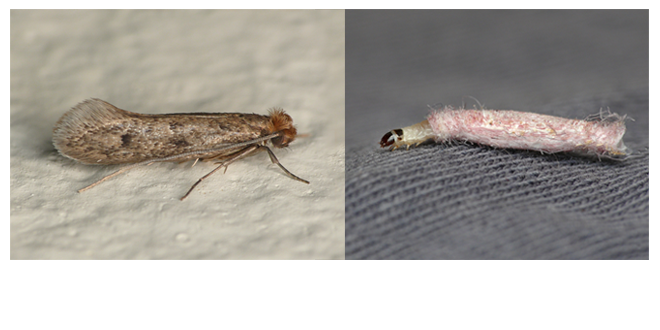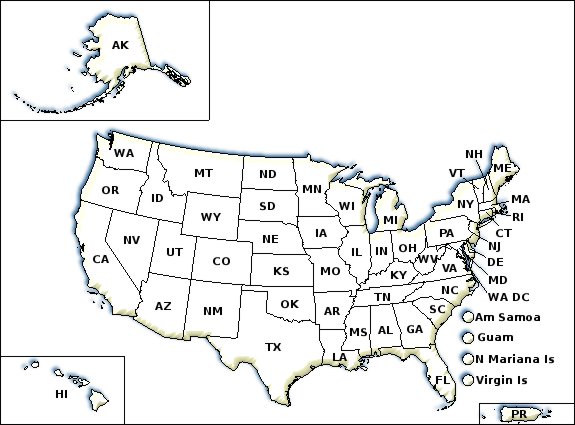Clothes Moths
1.800.858.7378npic@oregonstate.edu
We're open from 8:00AM to 12:00PM Pacific Time, Mon-Fri
A to Z
Clothes Moths

Clothes moths can cause damage to several animal materials. These include wool, fur, hides, hair, and feathers. They are especially drawn to fabrics with sweat, food, or urine stains.
Damage may appear as thinner areas or holes where the larvae have grazed on the fibers. Damage to fur items will often expose areas of the hide, where the insects have clipped the hairs at the base.
They avoid light, are weak flyers, and tend to hide when disturbed. Therefore, you may not notice you have moths until damage is found on your items.
Prevention tips:
- Inspect used clothes, rugs, and furniture containing animal fibers (wool, fur, hides, hair, and feathers) before bringing them into the home.
- Check under collars, along seams, and in crevices of used items for larvae and damage.
- Larvae may hide in cases or tubes made from the fabrics they are eating, making them hard to see. Take your time to inspect items carefully.
- Use a flashlight to help you inspect fabrics. The larvae are small and can be difficult to see. Look for white caterpillars with dark heads, up to 1/2 inch long.
- Wash clothes in hot water or have them dry-cleaned before putting them in long-term storage.
- Store items in airtight bags and containers. Keep storage areas clean of dust, cobwebs, and pet hair.
- Use pheromone traps for adults in storage areas. Check regularly for signs of moth activity. Finding adults is a sign that there are larvae causing damage somewhere.
Control tips:
- Identify your pest to target your control efforts. Clothes moths may be confused with pantry moths or carpet beetles. Consider contacting your local Cooperative Extension Service for help identifying a pest.
- When moths are found, remove all items from the area.
- Clean using a strong-suctioned vacuum in cracks and crevices to remove any debris. Wash down walls, shelves, and other surfaces with soapy water.
- Launder items in hot water for 20–30 minutes to kill eggs, larvae, and adult clothes moths. Dry clean items that cannot be laundered.
- Non-washable items can be placed in a Ziploc bag and frozen for 2 weeks to kill the insects. Allow items to return to room temperature before removing from the plastic bag.
- Larger items can be hung outside, beaten, and brushed to remove eggs and larvae. Adult females glue eggs directly on fabrics.
- Heavy infestations may require hiring a Pest Control Professional.
- If you choose to use a pesticide, always follow the label. Try a lower toxicity product first.
- If using mothballs or flakes to kill insects on items that cannot be laundered or dry-cleaned, always follow label directions. These pesticides produce a gas that is toxic to people or animals if they breathe it in.
If you have questions about this, or any pesticide-related topic, please call NPIC at 800-858-7378 (8:00am - 12:00pm PST), or email us at npic@ace.orst.edu.
Clothes Moths
- Identify your pest. There are several beetle and moth species that damage home items.
- Find infested items first. Check any clothing containing wool, fur jackets and hats, wool rugs, hides, natural bristled brushes, and any items stuffed with hair or feathers.
- Remove all items from the infested area and clean thoroughly (vacuum cracks and crevices and wash with soap and water).
- Launder or dry-clean items to kill eggs and larvae, and remove stains that attract them.
- Place small non-washable items in the freezer for 2 weeks to kill the insects.
- Beat and brush items outside in the sun to dislodge eggs and larvae.
- Store all cleaned items inside airtight containers, and continue to monitor for signs of moths.
- Use pheromone traps to monitor the population.
- Mothballs are only to be used in airtight containers. The gasses they create may pose a risk to people and pets.
- If you choose to use a pesticide, always follow the label. Try a lower toxicity product first.
- If you have a pesticide product in mind, have your label handy and click here for information about that product.
County Extension Offices
Through its county agents, the Cooperative Extension Service gives individuals access to the resources at land-grant universities across the nation. These universities are centers for research in many subjects, including entomology (the study of insects) and agriculture. Each county within the United States has an Extension office, which is staffed with agents who work closely with university-based Extension specialists to deliver answers to your questions about gardening, agriculture, and pest control. You can find the phone number for your local county extension office in the local government section (often marked with blue pages) of your telephone directory or by clicking on the map below.

U.S. States:
AK | AL | AR | AZ | CA | CO | CT | DE | FL | GA | HI | IA | ID | IL | IN | KS | KY | LA | MA | MD | ME | MI | MN | MO | MS | MT | NC | ND | NE | NH | NJ | NM | NV | NY | OH | OK | OR | PA | RI | SC | SD | TN | TX | UT | VA | VT | WA | WI | WV | WY | Washington D.C. |
U.S. Territories:
Puerto Rico | American Samoa | Guam | Northern Mariana Islands | Virgin Islands
Additional Resources:
- Clothes Moths - University of California Statewide IPM Program
- Mothballs: Proper Use and Alternative Controls for Clothes Moths - Oregon State University Extension
- Clothes Moths - Rutgers NJAES Cooperative Extension
- Clothes Moths: Identification and Control in the Home - Colorado State University Extension
- Clothes Moths - Penn State Extension
- Clothes Moths - Utah State University Extension
